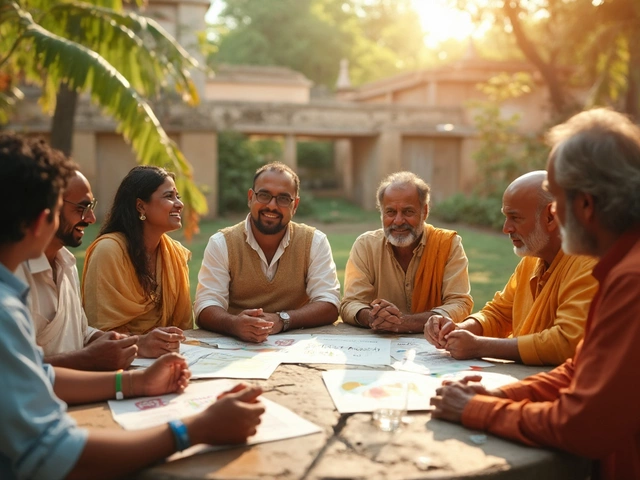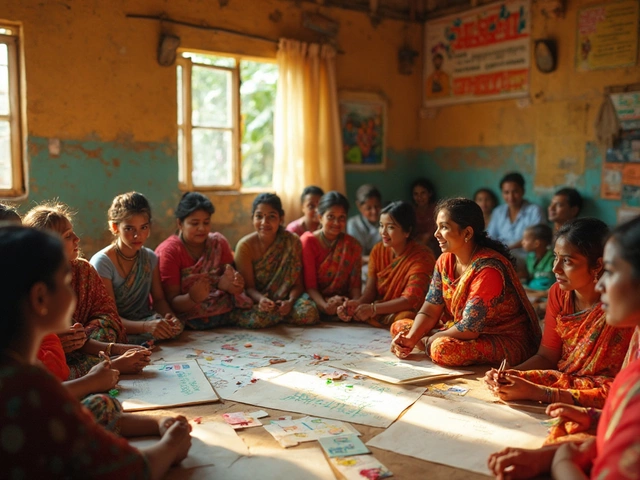If you’ve ever tried pulling off a community outreach project, you know winging it usually ends in confusion—or worse, crickets. The real trick is having a clear outreach plan right from the start. It’s not rocket science, but you do need more than just a vague idea. Every outreach plan has a few essential parts, no matter if you’re trying to get neighbors to a town hall or rally parents for a school event.
Think of an outreach plan as your playbook. You’ll want to know exactly who you’re talking to, how you’ll reach them, and how you’ll know if your efforts actually work. That means clear goals, a good sense of your audience, and picking the best ways to connect. Skip any of these steps, and things fall through the cracks—like sending postcards to teens (spoiler: they barely check the mail).
No need to guess what should go into your next outreach plan. Each section ahead will walk you through the nuts and bolts—no fluff, just real strategies you can use right now to get your message out there and make it stick.
- Setting Clear Goals
- Choosing and Understanding Your Audience
- Crafting the Right Message
- Picking Outreach Channels
- Action Steps and Timeline
- Measuring Success and Adjusting
Setting Clear Goals
Start any outreach plan by nailing down exactly what you want to achieve. Vague goals like "raise awareness" don’t cut it—they’re hard to measure and almost impossible to define as a success or failure. Clear goals work better because everyone on your team knows what you’re shooting for, and you can track progress without guesswork.
Think about what specific change you want to see. Are you hoping 50 new people will sign up for your community newsletter in a month? Want to double event attendance compared to last year? Pick real numbers and deadlines so you can actually see results. The SMART framework gets used a lot because it works: goals should be Specific, Measurable, Achievable, Relevant, and Time-bound. Here’s what that looks like:
- Specific: "Increase Facebook group sign-ups by 25% within three months."
- Measurable: You can count the changes—no guessing.
- Achievable: Don’t set yourself up for failure; the goal has to be realistic.
- Relevant: The goal actually connects to your project’s purpose.
- Time-bound: There’s a deadline, so you know when to check your progress.
Here’s a quick fact: A 2023 survey from the Community Tool Box found that projects with clearly written goals were 3 times more likely to hit their targets than those with fuzzy or informal aims.
| Goal Example | Good or Bad? |
|---|---|
| "Make more people aware of our program." | Bad (Too vague) |
| "Get 100 new volunteers signed up by July 20th." | Good (Clear and measurable) |
Check your outreach plan against your goal. Every detail—from the message to the timeline—should line up with what you want to achieve. If something doesn’t help you hit your goal, cut it out or tweak it. Clear goals keep everyone focused and save time later.
Choosing and Understanding Your Audience
Figuring out your audience is the backbone of a solid outreach plan. Miss the mark here, and even the best message won't land. Start by asking, “Who do we actually want to reach?” It sounds basic, but too many people skip this step and hope for the best.
Your target group might be young parents in your neighborhood, business owners on Main Street, or local teens interested in sports. If you’re not sure, run short surveys or chat with folks in the community—honestly, you’ll learn way more than guessing at your desk. According to the Pew Research Center, nearly 70% of people say they're more likely to get involved if they feel a message actually speaks to them. That says a lot about the power of knowing who you’re talking to.
Don’t lump everyone into one group—break your audience into segments. For instance, parents might want text alerts about school events, while older residents prefer phone calls or printed flyers. This saves time and money because you send the right message to the right people.
"The best outreach succeeds by meeting people where they are—not where you hope they’ll be." — Community Toolbox, University of Kansas
Start with a few simple steps:
- Pinpoint age groups, interests, and needs—ask real people or use local data.
- Figure out where your audience hangs out—online and in-person. Are they scrolling Facebook, checking community bulletin boards, or going to local coffee shops?
- Find out what motivates them. Some want to help the neighborhood, others look for networking, while some just want practical benefits.
Here’s a quick example of audience breakdown:
| Audience Segment | Preferred Channel | Main Motivation |
|---|---|---|
| Teenagers | Instagram, TikTok | Socialize, Recognition |
| Retirees | Flyers, Phone Calls | Community Safety, Belonging |
| Young Parents | SMS, Facebook Groups | Family Activities, Support |
The more you know your specific audience, the easier it is to plan. You’ll avoid shouting into the void and actually connect with real people who want to hear from you.
Crafting the Right Message
Nailing your message is everything. You don’t want your outreach to sound like spam or a jumble of buzzwords. The goal is to get folks’ attention, make it easy for them to understand what you’re after, and spark real action. A clear, relatable message can honestly make all the difference in the world of outreach plan success.
Here’s the kicker: the same announcement won’t work for everyone. If you’re talking to local business owners, their interests are way different than a bunch of high school volunteers or retired teachers. Instead of a one-size-fits-all, segment your audience and tweak your message for each group. Research shows emails tailored to specific groups are opened 26% more often than generic email blasts, according to Campaign Monitor’s 2023 data.
"The words you choose, and how you frame your ask, can motivate or lose your audience in seconds. It takes less than 8 seconds for a reader to decide if something’s worth reading," says communication consultant Nick Morgan.
Let’s keep it short, concrete, and action-oriented. Ditch the jargon. You want a line like "Join us Saturday to help clean up Riverside Park" instead of "Your valued participation is requested for the upcoming municipal sanitary initiative." People tune out if it sounds too formal or like corporate speak.
Try this checklist when building your message:
- Does it say clearly what you want the person to do?
- Do you mention how they’ll benefit or why it matters?
- Is the tone friendly but direct?
- Is any needed info—like time, place, or deadline—front and center?
- Is it free of jargon, acronyms, and complicated language?
For extra punch, add a call to action—something specific like “RSVP today” or “Bring a friend.” You’d be surprised how many outreach emails skip this last step.
Here’s a quick look at how message styles affect results based on a local outreach campaign study:
| Message Style | Response Rate |
|---|---|
| Personal, clear call-to-action | 42% |
| Generic group message | 19% |
| Corporate/formal language | 11% |
The numbers don’t lie: plain, personal, and straight to the point works best. That’s how you make sure your outreach isn’t just heard—but actually gets a response.

Picking Outreach Channels
This is where a lot of outreach plans sink or swim—figuring out which channels to use. Not everyone hangs out in the same place or prefers to get info the same way. Some folks never let go of their smartphone, while others still use flyers on the local bulletin board. So, picking the right outreach channels means meeting your audience wherever they actually spend their time.
These days, digital tools steal the spotlight. Platforms like Facebook, WhatsApp, and even Nextdoor are super popular for neighborhood updates and community discussions. A 2023 report from Pew Research showed around 72% of American adults use some form of social media daily, with Facebook leading the charge for community engagement. Text messaging is another winner, with response rates often beating email by a long shot—sometimes as high as 45%.
If your crowd leans older, don’t skip the classics: local newspapers, mailers, and in-person meetings. In 2022, the USPS reported that 62% of households read or scan direct mail. These tried-and-true methods can be surprisingly effective, especially when you want to grab attention quickly or reach people who aren't glued to screens.
"Choosing the right channels isn’t about being everywhere, it’s about being where your audience actually listens—and acts," says Susan Harmon, director of outreach at the National Civic League.
To help match channels to your audience, check out this quick overview:
| Channel | Best For | Strength | Weakness |
|---|---|---|---|
| Social Media (Facebook, WhatsApp, Nextdoor) | Adults 25-60, community groups | High engagement, easy updates | Not everyone uses, cluttered feeds |
| Text Messaging | Younger adults, quick reminders | Fast response, direct | Opt-in needed, limited info per message |
| Professional audiences, detailed info | Good for details, trackable | Can get ignored or land in spam | |
| Printed Flyers/Posters | Local communities, older adults | Tangible, localized | Limited reach, easily missed |
| Direct Mail | All ages (especially older adults) | Wide reach, personal touch | Costly, slower response |
A quick tip—don’t just pick one. Using a mix of channels increases your odds that your message actually lands. For example, if you’re running a community outreach event, post on Facebook, send a week-before text reminder, and drop a flyer at the corner store. That combo means fewer people slip through the cracks.
Finally, pay attention to what works. Track which channels bring people in or get the most responses, and tweak your plan as you go. Outreach is about experimenting, learning, and showing up where you’re most likely to be heard.
Action Steps and Timeline
This part turns your big ideas into a real plan. People talk about outreach a lot, but unless you split the work into doable pieces and set deadlines, things get forgotten fast. Break your outreach plan into clear action steps. Assign tasks, put names next to them, and add deadlines. That way, you don’t end up with one person doing everything the night before.
Start simple. For every outreach activity—like sending out a newsletter or setting up a local event—write down what needs doing, who’s doing it, and when it has to be finished. Here’s what that might look like:
- Make or update your email list (Sara, by June 3)
- Write the event invitation (Carlos, by June 5)
- Schedule social media posts (Jade, by June 7)
- Book event space (Megan, by June 8)
- Print handouts or flyers (You, by June 10)
You don’t have to use fancy software for this—but even simple tools like Google Sheets or Trello will help you track progress. Public Health studies often show that organizations who use project management tools finish work 30% faster and see less confusion within teams.
Let’s get real: just setting tasks isn’t enough if nobody sticks to the timeline. A timeline keeps you honest. It lays out every key deadline, from research all the way to the actual outreach day. Here’s a basic chart to get a feel for how this plays out in a typical outreach plan:
| Action | Responsible | Due Date | Status |
|---|---|---|---|
| Identify key community contacts | Team Lead | June 1 | Done |
| Design flyers | Graphic Designer | June 4 | In Progress |
| Send invitations | Communications Staff | June 8 | Pending |
| Set up event space | Volunteers | June 12 | Pending |
One big tip: check in with your team weekly. It takes just 15 minutes to see if things are on track, and it lets folks ask for help before anything gets missed. Keeping tasks crystal clear and sticking to a timeline is what separates detailed plans from last-minute scrambles.
Measuring Success and Adjusting
If you don’t check if your outreach plan actually worked, what’s the point? Measuring your results isn’t just ticking boxes—it’s how you make sure your time and effort paid off. You need some straightforward ways to figure out if you reached your targets or just shouted into the void. The key is to track things that matter, not just activities for the sake of being busy.
Start by picking what you’ll measure before you even launch your effort. Did you want more people to show up for a community cleanup? Are you hoping for more volunteers to sign up online? Nail down those specifics, then pick the numbers that really tell the story. These could be event attendance, sign-up rates, social media shares, or responses to a survey. The *best* measurement? One that ties straight to your main goal.
| Metric | Example Tool | What You’ll Learn |
|---|---|---|
| Event Attendance | Sign-in sheets, Eventbrite | Who actually showed up |
| Email Response Rate | Mailchimp analytics | Who opened and engaged |
| Social Media Reach | Facebook Insights | How many saw your message |
| Volunteer Sign-Ups | Google Forms | Real interest in your cause |
Don’t just check numbers once and move on. Review them after each outreach push—sometimes weekly, sometimes monthly, depending on your goals. If things didn’t go how you planned, that’s not a failure. See what worked, what bombed, and—most important—make changes. Say turnout was low but social shares were high? Maybe next time, focus more online or swap the event time. A study from 2023 showed community events that tweaked their approach based on feedback saw a 25% jump in participation the following year.
If you want your outreach plan to get better each round, make it a habit to collect feedback. Ask a few folks what grabbed them or turned them off. Combine their opinions with your numbers, and you’ll have an outreach process that keeps getting stronger instead of just repeating the same old routine.





